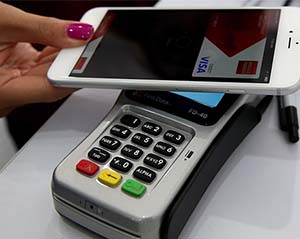 With Apple Pay launched in the UK recently, tracking in-store conversions could be about to transform! Google released the ‘Store Visits’ metric for AdWords at the end of last year, but how does it actually work and how can it be enhanced now contactless smartphone payment is catching on?
With Apple Pay launched in the UK recently, tracking in-store conversions could be about to transform! Google released the ‘Store Visits’ metric for AdWords at the end of last year, but how does it actually work and how can it be enhanced now contactless smartphone payment is catching on?
Firstly, here’s how the ‘store visits’ feature works:
When a user clicks on an ad, they are automatically given a unique ID called a ‘GCLID’ which is kept for 30 days. If this user then visits a physical store in the next 30 days, Google knows that this is the same person who clicked the ad (providing their location settings is turned on).
Clearly this is only an estimate since visiting a shop doesn’t always imply a conversion, plus not everyone has location settings turned on. Nonetheless it is still a useful tool and certainly a step in the right direction!
This is what the GCLID looks like when you click on an ad:
![]()
How accurate is this?
Well it’s important to say that these visits are only reported if Google is confident that it is an accurate estimate, for which there are strict guidelines. In the case of shopping centres where it might be difficult to differentiate between shops close together, Google is using local Wi-Fi networks to increase this accuracy.
So how can you set this up for your business? Well first there are some requirements:
- Have a Google My Business account linked to your AdWords account
- Set up location extensions in your Google My Business account
- Have multiple physical store locations
Receive thousands of ad clicks and many store visits (so there is enough data to work with)
If you’re interested in setting this up and you satisfy all the requirements then click here to find more details.
What about tracking in-store conversions?
At the moment, there is a way to track offline sales and not just store visits, but this only works to an extent. It essentially involves matching up the GCLID to the customer who is converting in the store. For example, let’s consider a car retailer. Imagine I click on their ad to do some research and I put in my details in some way; perhaps from requesting a quote or signing up for emails. If I visit the store in the next 30 days and purchase a car, then when I sign a contract – they gain my details again and can match me up to my GCLID manually. It’s a long process and only works in some situations but for businesses such as car retailers with high value conversions, it can be very useful.
For information on how to set this up, follow this link.
Has ‘store visits’ caught on?
Yes! The ‘Store Visits’ metric is helping to show which ads are at least driving more people to stores which in turn is contributing to sales. But the significant impact is for mobile ads with US retailers reporting, on average, 10 times more mobile conversions when including store visits. With sales through mobile devices often significantly lower than on desktop websites, it’s great to have evidence that mobile ads are seriously contributing to physical store visits!
The future
With the launch of Apple Pay in the UK, the ‘Store Visits’ metric can theoretically take the next step. Owners of iPhone 6’s and Apple watches will now be able to simply touch their device to a payment terminal to pay for anything less than £20 (£30 from Septem
ber). Unlike the US, contactless payment has taken off in the UK with a 255% increase in 2014; so Apple Pay could be a real hit!
If contactless payment on smartphones takes off, then tracking offline conversions could improve drastically. It would be as simple as Google storing your GCLID, tracking when you visit a physical store (like it can already) and then being informed as soon as you make a purchase! Tracking in-store conversions will always be an estimate since many people still pay with good old fashioned cash. However, the way things are going we could be looking at an almost cashless future where everyone simply waves their smart watches to pay for just about anything. Watch this space.


